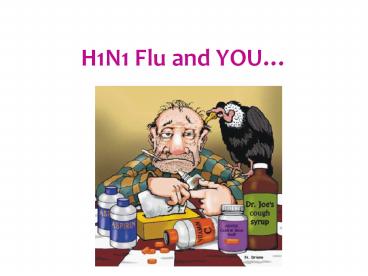H1N1 Flu and YOU - PowerPoint PPT Presentation
Title:
H1N1 Flu and YOU
Description:
Spread of novel H1N1 virus is thought to occur in the same way ... Symptoms. The symptoms of novel H1N1 flu virus in people include fever, cough, sore throat, ... – PowerPoint PPT presentation
Number of Views:60
Avg rating:3.0/5.0
Title: H1N1 Flu and YOU
1
H1N1 Flu and YOU
2
To you and you and you and you
- Spread of novel H1N1 virus is thought to occur
in the same way that seasonal flu spreads. Flu
viruses are spread mainly from person to person
through coughing or sneezing by people with
influenza. Sometimes people may become infected
by touching something such as a surface or
object with flu viruses on it and then touching
their mouth or nose.
3
Symptoms
- The symptoms of novel H1N1 flu virus in people
include fever, cough, sore throat, runny or
stuffy nose, body aches, headache, chills and
fatigue. A significant number of people who have
been infected with this virus also have reported
diarrhea and vomiting. Severe illnesses and death
has occurred as a result of illness associated
with this virus.
4
Is this Serious?
- Illness with the new H1N1 virus has ranged from
mild to severe. While most people who have been
sick have recovered without needing medical
treatment, hospitalizations and deaths from
infection with this virus have occurred.
5
Whose at Risk?
- People 65 years and older, children younger than
five years old, pregnant women, and people of any
age with certain chronic medical conditions. - About 70 percent of people who have been
hospitalized with this novel H1N1 virus have had
one or more medical conditions previously
recognized as placing people at high risk of
serious seasonal flu-related complications.
6
How long are you contagious?
- People infected with seasonal and
- novel H1N1 flu shed virus and may
- be able to infect others from 1 day
- before getting sick to 5 to 7 days after.
- This can be longer in some people,
- especially children and people with
- weakened immune systems and in
- people infected with the new H1N1
- virus.
7
Prevention and Treatment
- Cover your nose and mouth with a tissue when you
cough or sneeze. Throw the tissue in the trash
after you use it. - Wash your hands often with soap and water,
especially after you cough or sneeze. - Avoid touching your eyes, nose or mouth. Germs
spread this way. - Try to avoid close contact with sick people.
- If you are sick with flu-like illness, It is
recommended that you stay home for 24 hours after
your fever is gone. Keep away from others as much
as possible to keep from making others sick.
8
Can household cleaning help prevent transmission?
- Yes. Studies have shown that the virus can live
on a surface and can make a person sick for up to
2-8 hours. To help prevent transmission, all hard
surfaces, such as doorknobs, refrigerator door
handles, telephones, and bathroom surfaces,
should be washed with soap or detergent, rinsed
with water and then disinfected and rinsed.
9
Vaccinations
- At this time, there is no vaccine for novel H1N1
influenza. - You can receive a regular flu shot but it does
not protect you from the novel H1N1 influenza. - This makes the regular things you do to protect
yourself from the flu, such as covering coughs
and washing hands, all the more important.
10
Learn more about H1N1
- The Centers for Disease Control and Prevention
(CDC) www.cdc.gov/h1n1flu - The World Health Organization (WHO)
www.who.int/en - Www.ct.gov/ctfluwatch
11
- Submitted by Brittney Dullard,
- University of Connecticut

